The rose is considered by many gardeners around the world the queen of flowers. It comes in many varieties and it has played an important role in our history. Just like the rose rules above other flowers, some types of roses rule the rose family.
Such is the case of the Damask rose, whose beauty has inspired countless poets and lovers. Its sweet fragrance that is described by perfumeries as honey-like, with spicy and cognac notes. and beautiful blooms have enchanted people’s senses for thousands of years.
The Damask rose is also known as the Turkish rose, the Bulgarian rose, the Arab rose, or the Castile Rose. Not only is this rose beautiful and deeply fragranced, but it also has a lot of interesting properties.
Keep reading our article to learn more about this fascinating flower.
Quick Facts
| Fact | Detail |
|---|---|
| Name | Damask Rose |
| Other Names | Turkish Rose, Bulgarian Rose, Arab Rose, Castile Rose |
| Origin | Hybridized in Asia |
| Popularity in Europe | Became popular in Italy in the 16th century |
| Use in Perfumery | Its robust fragrance is used in perfumes and essential oils |
| Use in Cuisine | The rose buds are used for tea and in Middle Eastern and Indian cuisine |
| Medicinal Properties | Antibacterial, antioxidant properties, and has been linked to alternative treatments for HIV and diabetes |
| Symbolism | Love and purity |
| Flowering Pattern | Known to have a repeated flowering pattern |
| Cultivation | Suitable for USDA zones 4b to 9b |
| Propagation | Can be propagated through cuttings, division, layering, or grafting |
| Susceptibility | Prone to diseases, pests and requires regular monitoring |
| Lifespan | Profitable for about 25 years, but can live for up to 50 years if cared for properly |
| Size | Can reach a height of 220 cm and an average spread of 120 cm |
| Blooms | Usually in different shades of white and pink, but deep red is also common |
| Flowering Period | Begins between May and June |
About the Damask Rose
- This rose was created by double-crossing three different types of roses: Rosa Gallica, Rosa Fedtschenkoana, and Rosa Moschata. Since these three types of roses don’t share any natural habitats, it is safe to assume that the double-crossing occurred in cultivation.
- It is believed that this rose was hybridized in Asia, it was carried across the middle east and found its way to Europe in the Middle Ages. It became popular in Italy in the 16th century. The most popular variety was the Autumn Damask. At that time it was the only rose known to have a repeated flowering pattern. Due to this fact, it was known in Italy as “Rosa di Ogni mese” (the monthly rose). The French also had a similar name for it: Quatre Saisons (four seasons).
- The name of this rose comes from Damascus city in Syria, known for trading numerous quality goods, including fabrics, steel, and roses.
- Being one of the oldest types of roses, it served as a parent for a great number of rose varieties such as Bourbon, Portland, Angelina, Quatre Saisons, Blush Damask, Celsiana, and La Vile de Bruxelles, Ispahan, Autumn Damask, Leda or Hebe’s Lip.
- One of the most important characteristics of this rose is its robust fragrance. The intense fragrance makes it ideal for perfumes and essential oils. It is documented that people have been extracting rose water from the petals of the Damask rose since the 11th century. The method is rather simple. It involves infusing the rose buds in water for several days. As far as the essential oils go, the damask rose oil has a very low level of oil and it doesn’t have any synthetic substitutes. In addition to that, you need to process 4-5 tons of rose petals to get just one kg of rose oil. As such, it is one of the most expensive essential oils.
- Damask rose buds are used for tea. They have a zesty aroma with a hint of grapefruit flavour.
- These roses are edible. They are very common in Middle Eastern and Indian cuisine where they are used in desserts, flavoured rice, or spiced dishes.
- The medicinal properties of this rose have been studied for centuries. It has great antibacterial and antioxidant properties. Its scent is recognized to be very relaxing and even hypnotic. It has also been linked to alternative treatments for HIV and diabetes. In traditional medicine, it is used to relieve chest and abdominal pain and menstrual pain. It can also relieve neck inflammation and common coughs and it is also used as a gentle laxative. Rose oil is also used to ease depression and other nervous system problems.
- The Damask rose symbolizes love and purity and it is a part of many folkloric traditions. Rose water is often sprinkled at weddings to attract a happy marriage. This rose is particularly popular in Iran where it is known as the Flower of the Prophet Mohammad. Due to this association with the Islamic religion, many Hindus refused to cultivate this rose.
- This beautiful rose is also the official flower of the Island of Maui. In Hawaiian, it is known as Lokelani.
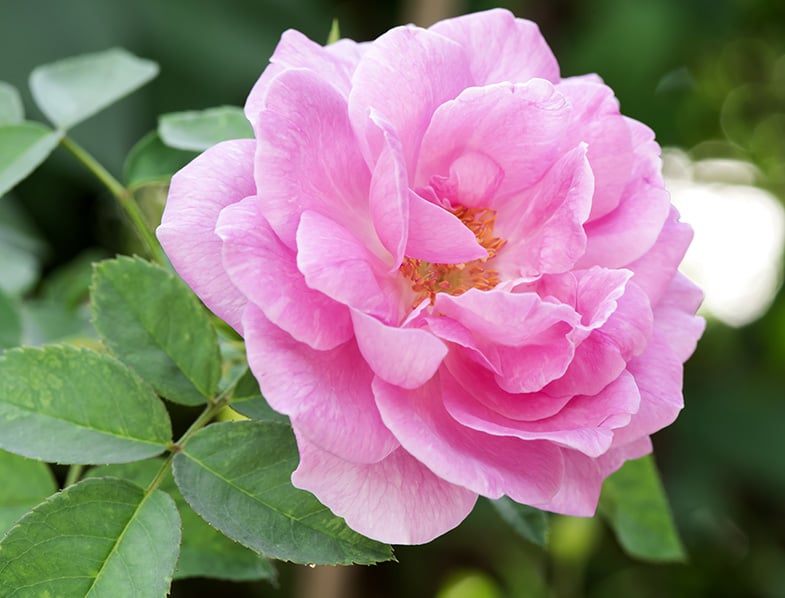
Damask Rose Features: An overview
- This rose bush can reach a top height of 220 cm and an average spread of 120 cm.
- This is one of the most long-lived rose bushes. From a cultivator’s point of view, it is profitable for about 25 years, but it can live for up to 50 years if it is cared for properly.
- This deciduous shrub features thin stems densely packed with prickles and bristles.
- The light green leaves of the damask rose are pinnate, meaning that they are arranged on each side of a stalk. The leaves have 5-7 leaflets with serrated edges. The length of the leaves ranges from 2 to 6 cm, and their width ranges from 1,2 to 4 cm.
- The rose blooms are usually in different shades of white and pink, but deep red is also common. The sepals are twice as big as the flower buds, featuring slender tails.
- The receptacle is narrow and campanulate, ellipsoid, or funnel-shaped. Depending on the variety, the flowers can have a green eye at the centre, a yellow button, or the centre can be hidden altogether. The number of petals can differ greatly from one variation to another. According to a morphological study conducted recently, the number of petals recorded in different variations ranges from 17 to 159.
- The flowering period can start between the beginning of May and the beginning of June.
- All Damask roses bloom in the summer. The ones that have only one blooming season are called Summer Damasks. There is a second type of Damasks which has another blooming season in autumn. As you can imagine, these roses are called Autumn Damasks (Rosa Damascena Semperflorens). The summer blooming season usually delivers a more impressive display of roses. This is because the warm weather favours blooming. Nonetheless, the roses that have a fall-blooming season are also beautiful and worth cultivating.
- The blooms of summer Damask can vary in colour from white and light pink to dark pink. The blooms grow in small clusters, have a loose appearance, and very strong scent. Summer Damask is considered one of the most important types of Old Roses for its key role in the development of other rose varieties.
- Autumn Damask produces smaller pink flowers that appear in clusters or singly. It is the oldest rose to bloom reliably more than once per year and is among the most important historical roses.
- While all Damask roses are known for their robust scent, the scent can vary from one rose to another. The scent is influenced by the petal colour, the flowering date, and the size of the leaflets.
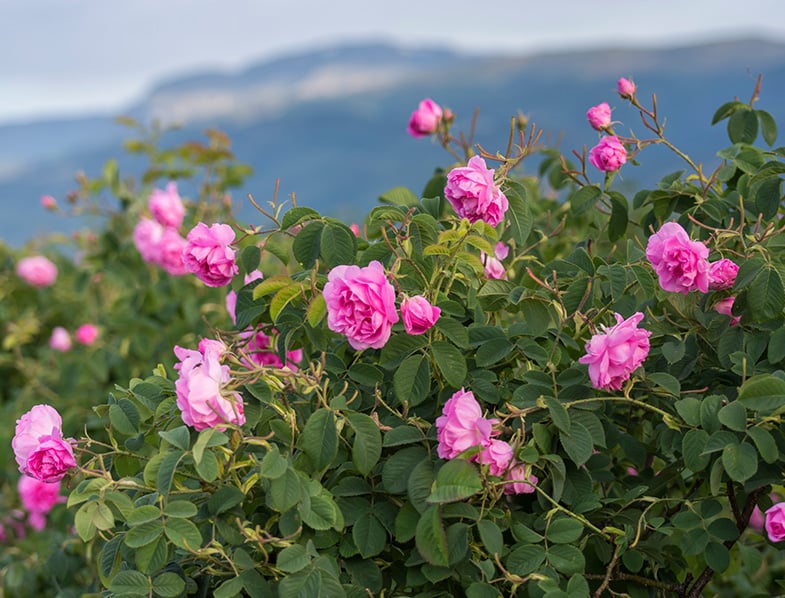
Growing Damask Roses
The Damask rose is suitable for USDA zones 4b to 9b. It is hardy and cold tolerant, but it grows better in a mild, temperate climate. It can grow in harsher climates, but it will bear fewer blooms which will wither faster than they would in warmer climates. It grows best in slightly acidic soil and fertile loam.
This rose is susceptible to diseases, so proper pruning and deadheading are essential. This helps to improve airflow and prevent diseases. Summer Damaks must be pruned only after flowering. This is because they only bloom on old wood.
Autumn damasks also bloom on new wood so they can be pruned whenever it is considered necessary. When pruning, cut back side shoots by one-third. This will not only improve the overall aspect of the bush but will also encourage the growth of new canes.
Deadheading will also encourage continuous blooms. Organic mulch is also beneficial to improve the soil’s level of moisture and the accumulation of nutrients. Some experts recommend using coconut chips as mulch. This rose has a sprawling habit so it can be grown as a climber, provided that it is offered adequate vertical support.
The Damask rose can also be grown in a pot, provided that you change it regularly to accommodate its growth. It grows at a medium pace so you don’t have to worry about changing the pot too often. It should be repotted once a year or when it doubles in size, whichever comes first. If you repot it yearly, there is no need to use fertilized because fresh soil is already packed with nutrients.
These roses are very susceptible to pests and diseases so make sure to check them regularly. This way you can deal with potential problems from the early stages of their development.
Some of the problems that you might encounter include aphids, thrips, spider mites, whiteflies, powdery mildew, and caterpillars. Most of these problems can be prevented with proper maintenance. Air circulation is vital so make sure to keep the weeds down and prune and deadhead whenever it is necessary.

Planting Damask Roses
In a commercial crop, the rose hedges are planted in a row to protect the flowers from the wind. You don’t have to plant the rose hedges in a row in your garden, but it would be wise to provide some wind shelter. After all, it is essential to protect the delicate flowers.
Nonetheless, some partial shade is recommended in the hotter months. The ideal location for Damask roses should get at least 6 hours of daily sunlight, with a nice afternoon shade. As far as spacing goes, allow at least 1 meter around the young rose bush. Proper spacing allows the plant to grow without inconveniences and it also allows for good air circulation.
When it comes to the planting procedure, the Damask roses are no different than your average rose. Start by digging a 45-50 cm deep hole with a similar spread. Enrich the hole with aged manure and compost. Plants with bare roots should be soaked the night before planting.
- Hardiness zone.4-9
- Grow.After having gone through their “stratification” time, take the containers out of the refrigerator and into a warm environment of around 70 degrees F. (21 C.).Once in the proper warm environment, the rose bush seeds should start to sprout. The rose bush seeds will usually continue to sprout over the course of two to three weeks.
- Edible.These roses are edible. They are very common in Middle Eastern and Indian cuisine where they are used in desserts, flavoured rice, or spiced dishes.
- Taste.They have a zesty aroma with a hint of grapefruit flavour.
- Self-seeding.Grow from seed and enjoy growing with your family
- ✅ ABOUT PRODUCT- This package contains New Fresh Heirloom Damask Rose Flower Seeds Generic , SEEDS ONLY, no live plants.The photos show are the mature plant in the future, not the actual plant you will receive
- ✅ PREMIUM FLOWER SEED MIXTURES - 100% NON-GMO pure plant seed mixes without any fillers are expertly blended considering height, color, bloom time and more so that the resulting meadow looks as pleasant as possible throughout the entire season
- ✅QUALITY - All seeds packaged by Seed Needs are intended for the current and the following growing seasons. All seeds are stored in a temperature controlled facility that is free of significant amounts of moisture.
- ✅GERMINATION - Seed Needs packets contain some of the freshest seed available. Direct from the growers. If sown correctly, you will begin seeing results in only a matter of days
- ✅ REACH US -If you do not satisfy with the products, please do not leave negative/neutral feedback. You can contact us for solution. We will try our best to fix the problem as soon as possible
- ✅ ABOUT PRODUCT- This package contains , SEEDS ONLY, no live plants.The photos show are the mature plant in the future, not the actual plant you will receive
- ✅ PREMIUM TREE SEED MIXTURES -Premium Seed Mix is a blend of high quality ingredients and fertilisers designed specifically for germinating and growing from seeds with vigorous
- ✅QUALITY - All seeds packaged by Seed Needs are intended for the current and the following growing seasons. All seeds are stored in a temperature controlled facility that is free of significant amounts of moisture.
- ✅GERMINATION - Seed Needs packets contain some of the freshest seed available. Direct from the growers. If sown correctly, you will begin seeing results in only a matter of days
- ✅ REACH US -If you do not satisfy with the products, please do not leave negative/neutral feedback. You can contact us for solution. We will try our best to fix the problem as soon as possible
Last update on 2024-09-24 / Affiliate links / Images from Amazon Product Advertising API
Hydrated roots will have an easier time establishing themselves in the ground. It also helps the plant if you fill the hole with water before planting. To put the roots in an optimal position, create a small mound in the centre of the hole, put the plant on the mound, and spread the roots around it. Make sure that the swollen knob from which the canes grow is placed just above the soil level.
Potted roses require a hole of a similar size to their pot and need to be planted at the same depth as they were planted in the pot. After planting, tamp down the soil to give the new plants proper support. Water thoroughly after the planting procedure.
Watering Damask Roses
The Damask rose is a hardy plant with strong roots that gather a lot of nutrients and moisture from the ground. It doesn’t have demanding watering needs, but it depends on the local climate. Outdoor roses can usually make do with a weekly watering session, provided that you water them consistently. Thin out the watering session as the weather gets colder.
Potted plants require about one to three cups of water per watering session, depending on their size. They usually do well with one watering session per week. Like most roses, they like to have the soil relatively dry before being watered.
Young plants require more water than adult plants to gather as many nutrients as possible. Within the first year, you need to water them consistently, but they will be less demanding as they mature.

Propagating Damask Roses
There are several ways in which you can propagate Damask Roses. The most popular propagation method is cuttings. However, it can also be done through division, layering, or grafting.
Propagation through cutting
You can use different types of cuttings, depending on the season. For example, in early spring, after the dormancy period, you can use hard cuttings. In autumn and winter, you can use more tender cuttings. Avoid deep cuts when the temperatures drop to prevent freezing damage.
For cuttings, use older roses with branches that are a couple of years old. The cuttings must be taken from the middle section of the branches. Each cutting should be about 15 cm long with at least 2 full buds. Immediately after the cutting, you should cut the lower end of the cutting in an oblique mouth and the top end into a flat opening.
This will help prevent water evaporation. During spring, when the temperatures are rising, you can insert the cutting directly into the soil, at an average depth of 8-10 cm. You can also use nutritious mediums to improve the chances of success of your cuttings.
Rooting hormone and humidity tents are great for increasing your chances of success. Avoid rooting the cuttings in water because there is a high risk of root rot.
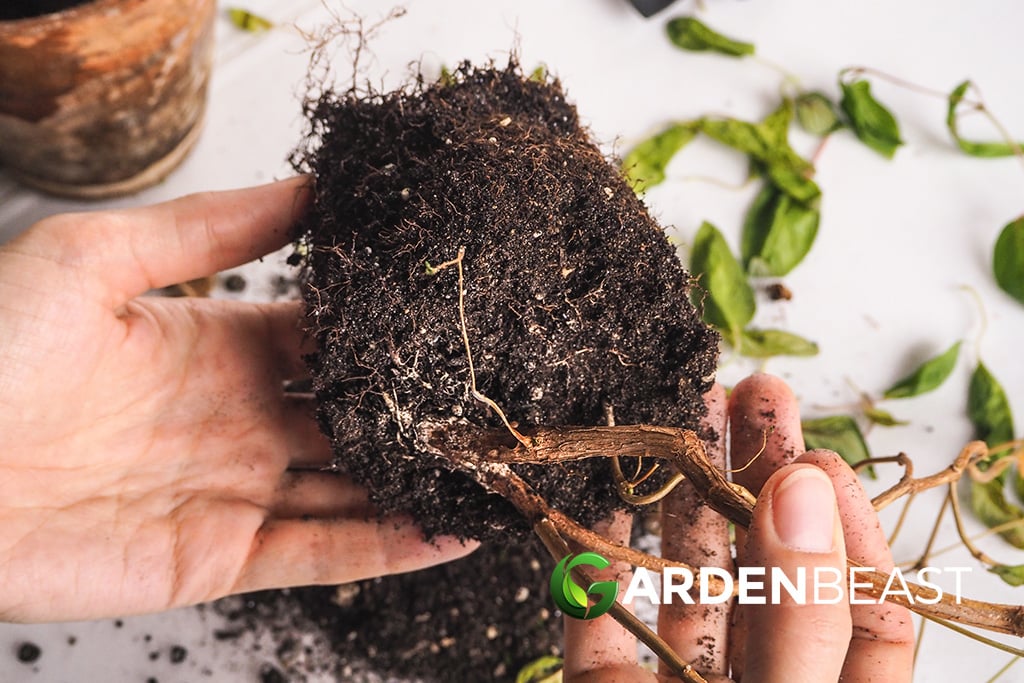
Propagating through division
Division requires more effort but it also has higher chances of success. The process is pretty straightforward as it is the same for all plants. Select a healthy plant with plenty of evenly distributed leaves and a good history of abundant blooms.
Timing is essential so make sure to do this in either early spring or late fall. Water the plant thoroughly to loosen the soil around its roots. Dig up the roots carefully and take them out of the ground. Cut it in equal halves with a sterile knife.
Keep the new plants moist and out of direct sunlight while you prepare their new planting spots. Plant them at the same depth as the original plant.
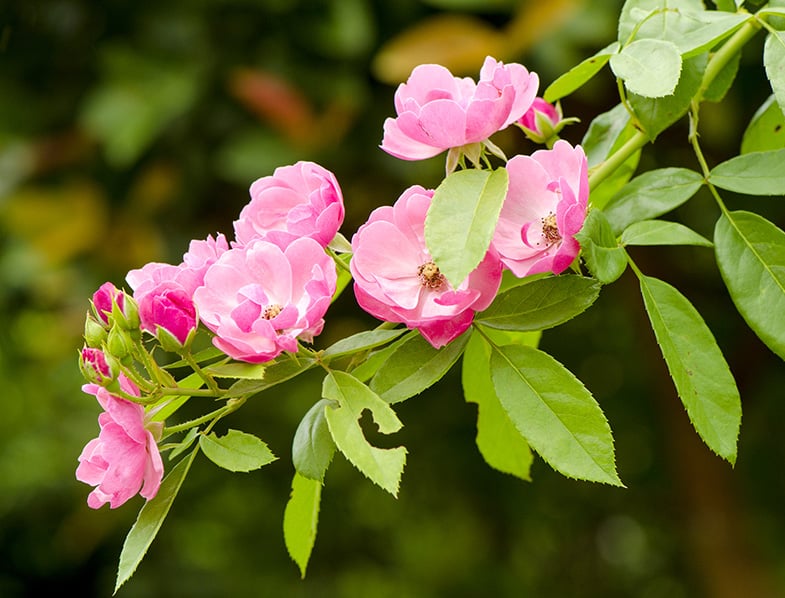
Layering
To layer, you need to pick a healthy semi-hard branch. Mark a section a few centimetres long and peel it until you uncover the white underskin. To encourage the growth of roots on the new plant, you will need to bury the peeled section.
You can also wrap it in either a plastic bag or a plastic container filled with potting soil. Once the chosen stem develops some steady roots you can cut it from the mother plant.
Grafting
Grafting is the process of transferring a rosebud to the stem of a different rose plant. It is usually done to strengthen a rose bush or to experiment with colours. This is not a process that is recommended for beginner gardeners.
Grafting is slightly more complicated than your average propagation. It is usually performed in mid-summer when the plant is actively growing. Use a sterile knife to cut a T shape. The slit should be about 2,5 cm long. Open the edges of the T-shaped slit.
Next, take a healthy bud from another plant. Don’t cut just the bud, but make sure to take a thin section of the stem, about 1,5 cm long, with the bud in the middle. Insert the bud section in the T-Shaped slit. Wrap it tightly with tape.
Leave the tape on until it falls off on its own. Soon enough, your new bud will turn into a bloom. This will either strengthen your existing plant, or it will allow you to experiment with a multicoloured bush.
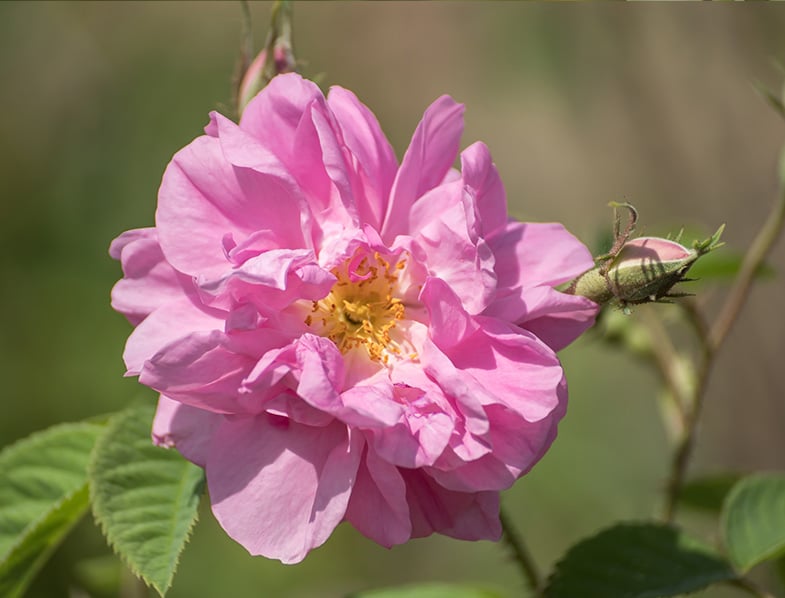
In Conclusion
The Damask rose has spread all over the world and it is a flower loved by most people. Its versatile nature allows it to easily integrate any garden design. Although it is not a high-maintenance plant, it requires slightly more care than your average garden plant. Its susceptibility to pests and diseases requires you to keep a close eye on it all year long.
Neglecting a problem can cause devastating events, and losing such a flower would be a terrible misfortune. As such, make sure to check it regularly and give it the best possible care. The alluring nature of this plant makes it a very common gift. However, keep in mind that this rose is not suitable for beginner gardeners as it requires a good amount of care. It looks good as a focal point but it is also suitable for mass planting. No matter how you style it in your garden, it will surely enchant your senses. You can also cut the flowers for arrangements or use them for medicinal or beauty purposes.
Are you growing Damask roses? Share your experience in the comments section!
Damask roses FAQS
What is special about Damask rose?
The Damask rose, known scientifically as Rosa damascena, is a highly prized species of rose. It’s known for its fine fragrance which is rich, deep, and intensely rosy. It’s extensively used in perfumery and also in the production of rose water and rose oil. Moreover, the Damask rose has a fascinating history, being connected to stories and cultures dating back thousands of years.
Where are Damask roses from?
The Damask rose is believed to have its roots in ancient Persia (modern day Iran). It gets its name from Damascus, the capital city of Syria, as it was brought to Europe from this city during the Roman Empire. Today, they’re cultivated widely in many parts of the world, particularly in Iran, Bulgaria, and Turkey.
Are Damask roses rare?
Damask roses are not considered particularly rare as they are cultivated in many parts of the world. However, due to the specific environmental conditions they require for optimal growth and the short blooming period (they typically bloom only once a year), the process of obtaining products like rose oil and rose water from Damask roses is labor-intensive, which can give the impression of rarity.
Why is Damask rose so expensive?
Damask roses are expensive mainly due to the laborious and time-consuming process of harvesting and processing. These roses bloom for a very brief period each year, and they must be handpicked during a specific time of day to ensure the fragrance is at its strongest. Also, it takes thousands of roses to produce a small quantity of rose oil or rose water, adding to the high cost of these products.
What is the rarest type of rose in the world?
The Juliet Rose is often considered one of the rarest and most expensive roses in the world. This rose, created by renowned rose breeder David Austin, took 15 years and a reported $5 million to develop. Its unique apricot-hued petals and beautiful form make it highly sought after. However, it should be noted that the “rarity” of a rose can depend on various factors, including geographical location, cultivation practices, and commercial availability.




1 Comment
Grew autumn damask roses about 30 years ago. Always plant for fragrance
.Switched over to climbing Cecile Brunner. Punk and fragrant.